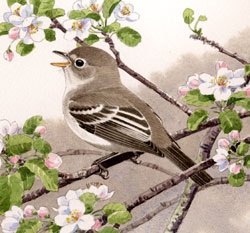Breeding Bird Atlases (BBA)
Find a Bird - BBA1
Breeding Bird Atlas 1 Species Accounts
Least Flycatcher
Empidonax minimus
Egg Dates
May 20 to July 1
Number of Broods
one or two; may re-lay if first attempt fails

The Least Flycatcher, or Chebec, is the most widely distributed and familiar Empidonax flycatcher in Massachusetts. During this century, it has declined slowly with the reversion of agricultural lands to deep forest, but it is still a widespread and common nesting species across the state east to and including most of Worcester County. However, it has disappeared from much of its former range in eastern Massachusetts, where it was still common into the 1950s. This change has been variously attributed to the decline and disappearance of orchards, agricultural lands, and other favored habitats; increased habitat fragmentation; and intensive insecticide spraying programs that have been widely carried on in rapidly suburbanizing eastern Massachusetts. A handful may rarely nest on Cape Cod west of Barnstable, but otherwise it is absent from Cape Cod and the Islands.
General arrival from the south occurs in the first week of May. Males at this time are notably active and pugnacious, earning the early appellation, Little Feathered Warrior. Rival males and other species are driven from territories, and females are chased about in noisy pursuits. Territories are well established by the third week of May. The advertising call in this species may serve as a form of territorial display. This call, a vigorous che-bec, accompanied by a jerk of the head and tail, is often uttered incessantly through the hottest days of summer. Males often call, as in other tyrannid flycatchers, at a noticeably quickened tempo, sometimes up to 60 times per minute, as day is breaking. At times, other notes are interspersed among the che-becs. A guttural wheu-wheu-wheu series may be given near the nest. The common call note of both sexes is a simple whit.
Preferred habitat includes relatively open deciduous woodlands and wooded swamps where trees are separated by slight spaces. Where trees are not separated, birds will accept scattered forest openings but will not tolerate too many limbs beneath the canopy, which should be at least 30 percent open and contain scattered dead branches and twigs for perches. The open undercanopy provides air space for foraging birds engaged in hunting insects on the wing. In other areas, birds seem to accept old neglected orchards, large shade trees about farms and gardens, advanced second growth, the edges of forests, and not-too-thickly wooded swamps.
Nests are placed 8 to 40 (usually less than 25) feet above the ground in small hardwoods in the crotch of a horizontal forking branch. Bent reported that two-thirds of the nests he discovered in eastern Massachusetts were in apple trees in orchards. Others were in Pitch Pines at 7 to 15 feet, near the ends of branches, or close to the trunk. Two recent Worcester County nests were located respectively at 20 feet in a Red Maple and 30 feet in a White Ash (Meservey). The neat, compact nest is formed as a deep, thin-walled cup with an outside diameter of 2.5 to 3 inches. The bowl is formed from shreds of the inner bark of trees, weed stems, and grasses, and is lined with finer grasses, milkweed down, and various hairs and feathers. Nest construction is completed in 6 to 8 days.
The first sets of eggs are generally completed in the first week of June. Clutches of three to four (rarely five to six) creamy white, unmarked eggs are laid, with eggs deposited in the nest on successive days. Clutch sizes for 4 Massachusetts nests were three eggs (1 nest), four eggs (3 nests) (DKW). The incubation period is 14 days. The female does all the incubating, with the male reported to feed her in the nest. Both parents tend the altricial young. The young are fed heavily from daybreak to midmorning and again during the late afternoon. Data on nestling dates in the state is lacking. Fledging occurs at 15 to 16 days, after which the adults continue to care for young for up to 20 days. A pair in Quabbin was feeding fledglings on July 29. Several authors state that two broods a season are reared in Massachusetts, and, although positive evidence is lacking, the July egg dates do suggest that this may occur. The birds will renest if the first attempt fails.
Least Flycatchers scatter and roam the woodlands in multispecies assemblages in August. Local birds begin to depart in the last week of August, and most are gone by mid-September. Migration is southwestward to Texas and south to the principal wintering areas in southern Sonora and Tamaulipas south along both slopes of Middle America to Honduras and northern Nicaragua.
Map Legend and Data Summary
Atlas 1 data collected from 1975-1979


Note: fairly common in open woodlands in central and western regions but uncommon and declining in eastern sections
Bradford G. Blodget



